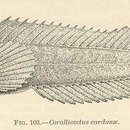Diagnostic Description
provided by CoralReefFish
Diagnosis: The modal fin-ray count of D-XVIII,11 or 12 A-II,18 to 20 P-13 with 29 or 30 total dorsal-fin elements indicates Coralliozetus cardonae and some labrisomids of the 18-spined Labrisomus. Many other Labrisomus and some Malacoctenus overlap the fin-ray count, but they are larger and more heavily marked than Coralliozetus larvae at comparable stages and have many more procurrent caudal-fin rays (6-10 vs 3-4). A rare Emblemariopsis will share the low fin-ray count with C. cardonae, but Emblemariopsis have the first three dorsal-fin spines close together and a relatively wide gap between the 3rd and 4th spines (vs. normal 3-4 gap). Although C. cardonae quickly develop a blunt snout after settlement, the larvae have a pointed snout. (DNA) Description:
- license
- cc-by-3.0
- copyright
- www.coralreeffish.com by Benjamin Victor
Diagnostic Description
provided by Fishbase
Species distinguished by: cirri on eye simple, arising from 2 separate bases; segmented dorsal-fin rays 11; total dorsal-fin elements 29 or 30; pectoral-fin rays usually 13; tip of lower jaw without fleshy projection; top of head never spiny; one row of teeth on each palatine bone. Common amongst Chaenopsids: small elongate fishes; largest species about 12 cm SL, most under 5 cm SL. Head usually with cirri or fleshy flaps on anterior nostrils, eyes, and sometimes laterally on nape; gill membranes continuous with each other across posteroventral surface of head. Each jaw with canine-like or incisor-like teeth anteriorly; teeth usually also present on vomer and often on palatines (roof of mouth). Dorsal-fin spines flexible, usually outnumbering the segmented soft rays, spinous and segmented-rayed portions forming a single, continuous fin; 2 flexible spines in anal fin; pelvic fins inserted anterior to position of pectoral fins, with 1 spine not visible externally and only 2 or 3 segmented (soft) rays; all fin rays, including caudal-fin rays, unbranched (simple). Lateral line absent. Scales absent (Ref.52855).
Morphology
provided by Fishbase
Dorsal soft rays (total): 11; Analspines: 2
Biology
provided by Fishbase
Inhabits eroded limestone slopes doted with small brain corals, sea-fans, whips, sea urchins and the like (Ref. 5521).
- Recorder
- Christine Marie V. Casal
Coralliozetus cardonae: Brief Summary
provided by wikipedia EN
Coralliozetus cardonae, the twinhorn blenny, is a species of chaenopsid blenny found in coral reefs in the western Atlantic ocean. It can reach a maximum length of 8.5 centimetres (3.3 in) TL.
- license
- cc-by-sa-3.0
- copyright
- Wikipedia authors and editors

